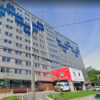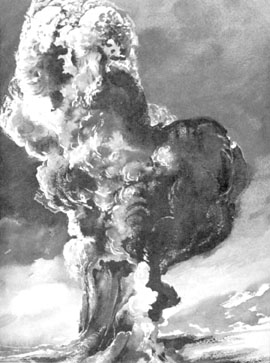
(August 6) – The 75th Anniversary of the dropping of an atomic bomb on Hiroshima on the Sixth of August 1945 is a historic universal event with profound immediate significance to present international relations, the danger of war and even nuclear war. For Haligonians, the nuclear devastation of Hiroshima and Nagasaki has a special meaning ,which is even more poignant in the wake of the hugely destructive explosion in Beirut, Lebanon on August 4.
On the Sixth of December 1917 the largest man-made explosion prior to Hiroshima took place here, when the munitions ship Mont Blanc loaded with 2,652 tons of chemical explosives and the Belgian relief ship Imo collided in the narrows of the harbour, adjacent to densely populated civilian quarters. Some 1,963 innocent men, women and children were massacred, another 9,000 injured and 199 blinded, comprising more than one fifth of the total population of less than 50,000. One square mile of the working class quarter of the North End facing the Halifax Narrows was totally destroyed. Six thousand people lost their homes altogether and between 20,000 and 25,000 Haligonians were left homeless and destitute, including ten thousand children. More than 1,600 buildings were destroyed, and 12,000 more were damaged. Whole groups of people such as African Nova Scotians and the Mi’kmaw were denied compensation by official authorities. [1]
It was the largest man-made explosion before Hiroshima. Its force was so great that people in Truro, over 100 kilometres away, felt the tremor. The anchor from one of the ships, the Mont Blanc, blew over the peninsula to land on the southerly side of the North West Arm where fragments remain to this day. Aside from the absolute force of the explosion and the devastation, the Halifax Explosion is distinguished by the lack of nuclear fall out, contamination and lesser loss of life.
Not to be forgotten is that just 18 days before Hiroshima, a second explosion,(pictured) on July 18, 1945, was initiated when an ammunition barge blew up at the naval magazine jetty on the inner Bedford Basin of the Halifax harbour. Naval vessels were being refit for new duties in the Pacific. As part of the process, all ammunition was being removed from ships in port. “By July 18th, the Bedford Basin magazine held enough shells, bombs, mines, torpedoes, depth charges, and a quantity of the new secret explosive RDX to blow Halifax off the face of the earth,” wrote Thomas Raddall in Halifax: Warden of the North in 1948. [2]
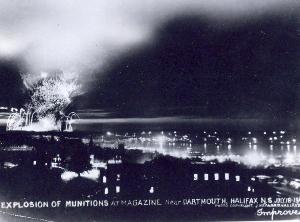
As different as the explosions at Hiroshima and Nagasaki may be from the earlier Halifax explosion, they share some things in common.
The Halifax Explosion occurred during an imperialist world war for the redivision of the globe in the context of unbridled drive for war profiteering, in which all safety precautions were thrown to the wind. Far from being an exceptional, once-in-a-lifetime “accident” or “an act of God” or manslaughter caused by the negligence of an individual ship’s captain or pilot or even sabotage by socialists, this tragedy was entirely preventable. The federal cabinet of Sir Robert Borden, the U.S. authorities who consciously diverted the badly-loaded Mont Blanc with its 2,652 tonnes of munitions from New York to Halifax, and the Royal Navy and Halifax port authorities, were all aware of the threat. All the official parties abdicated their social responsibility. It was a war crime.
Nothing about how the Halifax Explosion and Hiroshima and Nagasaki came to pass – the characters, ships and places, the scale of ambition, the ethical dilemmas evoked, its impact on our history – can be diminished. Scores of books have tried to elide its moral complexities, sculpt cause-and-effect around its every turn, answer every question. The books are best left on the shelf.
Hiroshima and Nagasaki occurred as the anti-fascist world war against Hitlerite Nazi Germany, Mussolini Italy and Japanese Militarism was at an end. It was an unjustified and naked demonstration of the might of the United States empire. To this day, the U.S. and its apologists argue that the Japanese cities were legitimate military targets and that their apocalyptic destruction was righteous, moral and proper. Eisenhower, MacArthur and five other U.S. generals disagreed. They were opposed to using the bomb. With all the other evidence put forth since then, including primary documents, there is no longer any debate on this issue. [3] The view of the apologists ignores the reality of the wholesale slaughter of the innocent civilian population, an act in violation of international law. The bomb the U.S. dropped on Hiroshima was made of uranium and instantly killed about 140,000 people in the initial blast of its estimated population of 350,000 and ultimately more than 237,000 in total. Of the 78,000 buildings standing in the city that August morning, nearly 50,000 were totally incinerated.
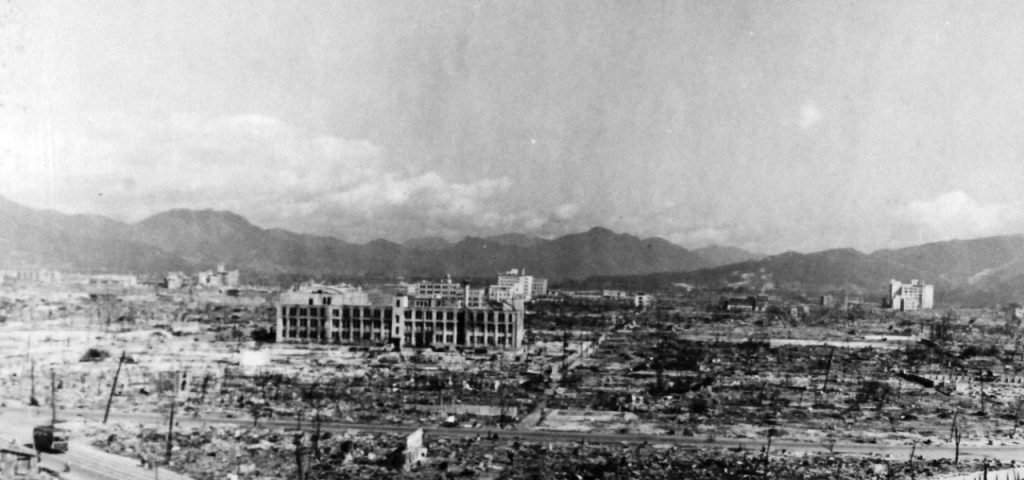
The bomb it dropped on Nagasaki was made of plutonium and killed 85,000 people in the initial blast and eventually resulted in the deaths of more than 70,000 additional people due to exposure to radiation and injuries. Thousands suffered their entire lives, as have the generations that followed, from the crimes committed on those days. This was a war crime.
Prior to this, using the experience of the firebombing of Dresden and other German cities, 334 United States B-29 bombers firebombed Tokyo on March 9, 1945 with napalm in an operation called Meetinghouse. They killed more than 100,000 people that day and many more were injured. The U.S. firebombed and largely destroyed more than 100 Japanese cities, leaving millions homeless. The “conventional” bombing was specifically designed to target civilians and infrastructure.
These were unprecedented and premeditated war crimes of mass murder which had nothing to do with the fight against Japanese militarism. Japan was suffering defeats everywhere and its surrender was imminent. But irrespective of that, such war crimes and mass murder are impermissible no matter the excuse.
This mass murder of civilian populations in Tokyo and then Hiroshima and Nagasaki served as a threat to the peoples of the world, especially the Soviet Union, that the U.S. had the monopoly on the use of force. Following the Korean War in 1950, the U.S. engaged the world in “nuclear politics” to blackmail the peoples into doing what the U.S. wanted.
The U.S. considered the use of nuclear weapons to settle the Korean War, Vietnam and wipe out China, but instead declared their use “unthinkable” and ”taboo.” In this way, the U.S. claimed such weapons were nonetheless necessary to act as a deterrent and that this was the main factor for peace in the world.
The sorcerer’s apprentice
There are two other little-known relationships between Halifax and Hiroshima and Nagasaki. The 1992 Ground Zero conference, organized by Alan Ruffman, an independent marine geophysicist, and historian Colin Howell of the Gorsebrook Institute, for the first time, publicly involved science in analyzing the Halifax Explosion. They set to rest the mythology of the precise time of the explosion which had been left in the shade.
The researchers also discovered a darker, more disturbing relationship, which had been kept secret by the government for 49 years. Scientific analysis of the Halifax Explosion was carried out by Oppenheimer’s group in the Manhattan Project in 1942 for the atomic bomb, to be targeted at highly populated, urban centres.
Writing of this little-known, universal dimension, Dr Ruffman noted: “…it is clear that the Halifax experience (helped scientists to) gauge the range of air blast effects and to estimate any possible tsunami created by a blast in a populated harbour city.” He concluded that the Halifax Explosion helped the American scientists in their decision to detonate bombs in mid-air at urban Hiroshima and Nagasaki in Japan, to produce a greater range of devastation: “Their research into what had gone before – including the Halifax Explosion – gave them insight into the potential of a nuclear bomb.” One war crime was the laboratory for and handmaiden of the other. [4]
The genocidaire
In 1913 a young American was recruited to join the faculty at Dalhousie University to teach engineering. During World War II as federal minister of Supply and Munitions possessing vast powers in the MacKenzie King government, C.D. Howe organized the supply of uranium from Canada for the U.S. atom bomb from Port Radium in the land of the Sahtugot’ine (Dene First Nation of Sahtú, Great Bear Lake). Declassified documents reveal that the danger from uranium was known during the mining operation. Neither the Canadian nor U.S. governments saw fit to make known the health dangers. Unaware of the radiation’s effects, the Sahtú Dene used “cloth sacks” to transport the ore. Their only protective clothing was gloves. In the early 1960s, the danger became apparent. The Sahtugot’ine workers started to die from lung, colon, and kidney cancers – diseases previously unknown to them. The Sahtugot’ine were sacrificed for an effort that ultimately slaughtered hundreds of thousands. [5]
Hundreds of Canadian scientists collaborated with U.S. and British scientists on the atomic bomb program, for which Canada supplied uranium and heavy water. Canada also had representation on the Combined Policy Committee, headquartered in Washington, that administered the atomic bomb program. Canada’s Howe was among its members who approved the use of the bomb on Japan. Howe declared in a public statement on August 6, 1945 that it was his particular “pleasure” to announce that Canada’s role “guarantees us a front line position in the scientific position that lies ahead.” Three days later, on August 9, Nagasaki was bombed. Liberal Prime Minister MacKenzie King recorded in his Diaries on August 6 that, “It is fortunate that the use of the bomb should have been upon the Japanese rather than upon the white races of Europe. I am a little concerned about how Russia may feel, not having been told anything of this invention or of what the British and the U.S. were doing in the way of exploring and perfecting the process.” [6]] In 1957, C.D. Howe was rewarded with an appointment at the behest of big capital to be the first chancellor of Dalhousie University: his remit was to develop atmospheric sciences as part of the Cold War, as epitomized in the race for space then underway. [7] Today the university is one of the most militarized in the country.
That same year the first Pugwash Conference was held in Nova Scotia based on the Russell–Einstein Manifesto of 1955 and the slogan to “Ban the Bomb,” while crucial work to establish the conditions required to preserve the peace was abandoned in the pursuit of nuclear politics. Post-war demands for denazification and to develop a peace economy were lost within the clamour to “Ban the Bomb!”
The Soviet Union developed nuclear weapons initially to hold the U.S. in check. However, by the 1960s, instead of the peoples’ cause for peace being made the centre of the foreign policy of the big powers, an arms race replaced the striving of the peoples of the world for peace. Expenditures on weapons soared. All five members of the UN Security Council also developed nuclear weapons and gave the green light for some of their allies to do the same.
Canada and weapons of mass destruction
When the people of Halifax commemorate the nuclear bombings of Hiroshima and Nagasaki this week, we keep these similarities in mind. On the national level, successive Canadian governments betrayed the call of Hiroshima and Nagasaki Never Again! by continuing to collaborate with the United States in the realm of weapons of mass destruction. As a founding member of NATO, Canada avidly supports that military bloc’s policy of “first-use” of nuclear weapons and is bound to it through secret agreements and covenants characteristic of such imperialist blocs. The total hypocrisy is to the extent that it also claims to be the greatest upholder of the Nuclear Non-Proliferation Treaty under the pretext of “security” when it comes time to attacking independent states such as Iran and the Democratic People’s Republic of Korea who are not kowtowing to the dictate of the United States while silent on the arsenal of nuclear weapons possessed by Israel.
Beginning at the end of World War II, vast amounts of deadly chemical and biological warfare agents such as mustard gas were deposited by the U.S. Armed Forces and the Canadian Department of National Defence off the Atlantic Coast of Canada despite protests of fishermen. [8]
Under a succession of secret agreements which originated at the time of the formation of NATO in 1949, successive Canadian governments allowed the United States not only to establish bases on Canadian soil but also to base and store part of its nuclear as well as chemical warfare arsenal in Canada. The sole government which disagreed, that of Conservative prime minister John Diefenbaker, was removed in 1963, in a covert operation of the John F. Kennedy administration headquartered in the basement of the U.S. Embassy in Ottawa, which was organized to install the Lester B. Pearson Liberals.
As many as 500 or more nuclear weapons were stored or deployed with the express permission of the Pearson cabinet but unknown to Canadians.
In terms of the U.S. navy, nuclear depth charges became the nuclear weapons most frequently carried into Canada.
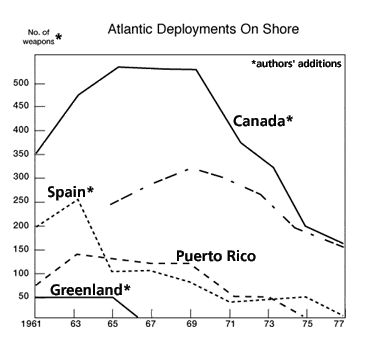
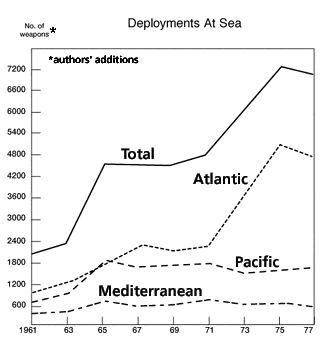
By 1965, there were over 100 U.S. bases and installations located throughout Canada. [9]
During the war of aggression against Vietnam, Canada secretly facilitated the testing of the chemical warfare Agent Orange at CFB Gagetown in New Brunswick, one of the most shameful and criminal legacies of the Pearson government.
A substantial portion of the depleted uranium in the DU weapons used by the U.S. in Afghanistan came from Canadian uranium exported to the U.S. and processed in U.S. enrichment plants into depleted uranium and subsequently manufactured into DU weapons. DU shells were used by the Canadian navy at Vieques Island in Puerto Rico and potentially radioactive shell casings dumped in the sea near Halifax. DU weapons are deemed weapons of mass destruction under international law. [10]
Under the Harper and Trudeau governments this trend of abject collaboration has reached a climax with new permanent arrangements that put U.S. security forces on Canadian soil and place all of Canadian land, sea and waterways shared with the U.S., such as the Great Lakes, under U.S. military command, along with aerospace.
This collaboration includes allowing testing of nuclear weapons delivery systems and permitting vessels and aircraft carrying nuclear weapons inside Canadian ports and territory. The nuclear armaments on the warships which “visit” Canadian ports include tactical, intermediate, and strategic weapons. In the same breath Canadian governments claim that it is not possible for it to know whether U.S. warships are carrying nuclear weapons because of the U.S. “neither confirm nor deny” policy and “operational security”. If it is not possible to know, then why has it established Nuclear Emergency Response Teams and conducts “mock disaster drills” in ports such as Halifax? [16]
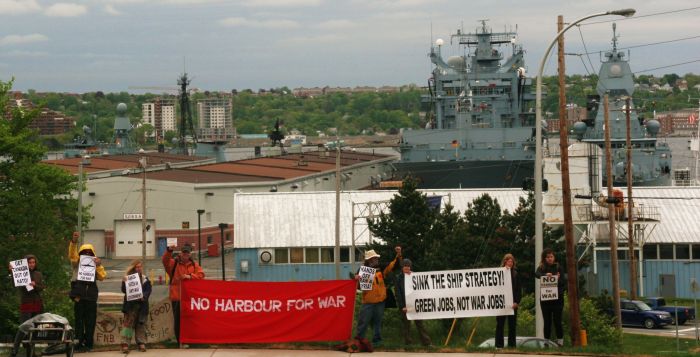
An attack submarine, an aircraft carrier strike group such as the USS Eisenhower – invited by the Trudeau government as part of the 2017 celebrations of the 150th anniversary of the confederation of 1867 [17] – and entire US-NATO fleets such as the September, 2019 Cutlass Fury exercise by their very name imply the threat of force and are a projection of U.S. military power. They are officially welcomed with open arms: no questions asked. Why should Canada receive such guests, who come to Halifax, Montreal, Vancouver or anywhere else festooned with all manner of arms, who claim to be here for friendly purposes? The U.S. is not an “ally.” Why should Canada’s own navy and military be similarly armed and have as one of its main objectives “interoperability” and “relative military autonomy” with the U.S. military? It means that, in the absence of any genuine democracy, the public right of the people of our country to live in peace and safety cannot be secured by these war governments. Even Parliament does not have a say over matters of war and peace, which are matters of executive privilege or the Royal Prereogative and its political use to enforce what cannot be justified is a greater problem than weapons of mass destruction.
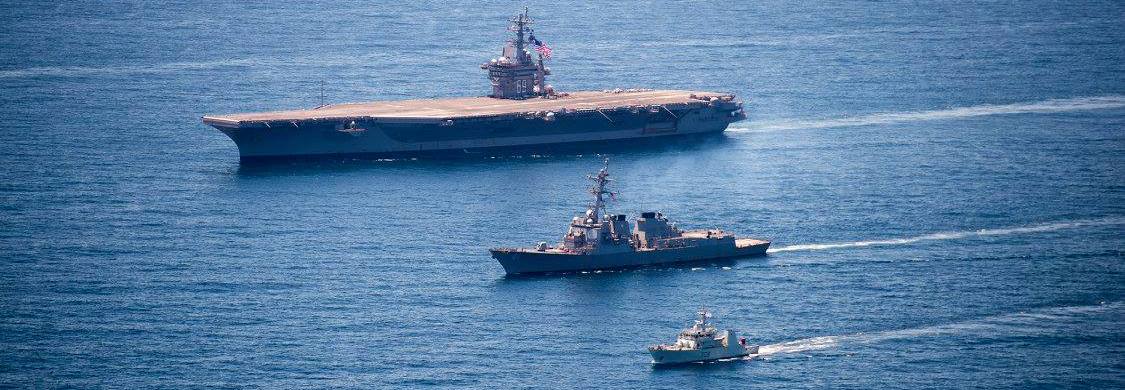
Hiroshima and Nagasaki Never Again!
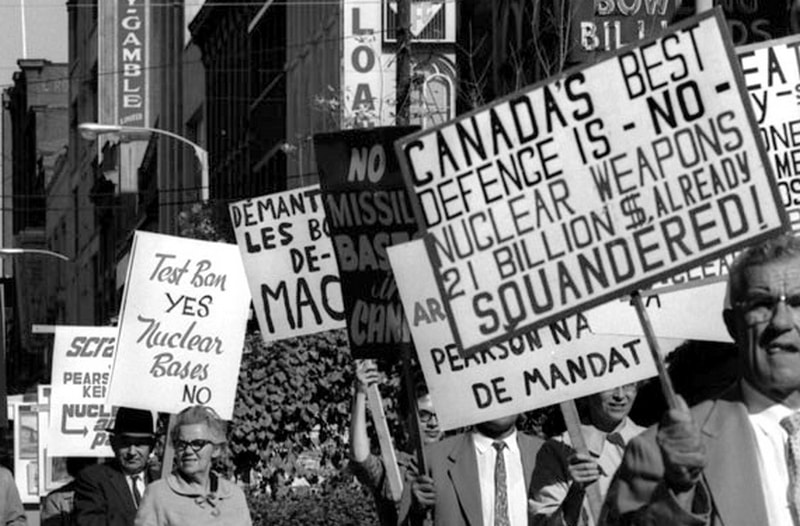
Canadians developed a movement against nuclear weapons from the 1960s on but it was not until the 1980s that a vigorous anti-war mass movement broke out in Halifax. Over the years thousands of Haligonians participated to oppose the all-sided preparations for war. The essence and thrust was to take up the question in their own hands.
The concrete focus was the harbour around the popular slogan “No U.S. or Soviet warships in Canadian ports.” The slogan highlighted the main source of the danger of war at the time. An important ideological battle was waged against the militarization of public space, Spectacles such as the Nova Scotia Tattoo (from 1979), Shearwater Air Show, freedom of the city ceremonies, open houses onboard visiting warships, tall ships, fleet reviews, “Dial-a-sailor” program [15]) aimed to justify the “visits” of warships and the militarization of the economy, the university and culture. In parallel, fearmongering with comic book shock and awe scenarios of Quinpool and Robie being in the cross hairs of a nuclear first strike from Russia or later following 9/11 ludicrous fantasies of terror strikes by jihadis sailing Arab dhows into the harbour were unleashed to force Haligonians to accept the unacceptable. The criminal propaganda and the falsification of history by the magnates of Halifax, the media and some reactionary cultural and literary figures aimed to create the psychology of war by implanting in the minds of the people the psychosis of the “military tradition” of Halifax. Activists fought this offensive tooth and nail.
A new narrative developed based on continuous study and investigation which was popularized through forums, meetings, pickets, newsletters and such films as the acclaimed “No Harbour for War” documentary shown nationally on Vision TV during the first Gulf War.
Further, annual commemorations of Hiroshima and Nagaskai began to take place although the demand to the city to declare a nuclear-free zone was unsuccessful. A similar movement, one can say a sister movement, emerged in the port of Vancouver and on Vancouver Island where the U.S. maintains a nuclear base at Nanoose, as well as in the ports in Quebec.
Its advancement necessitated a break with nuclear politics and the attempt to marginalize the peace movement into a lobby group.
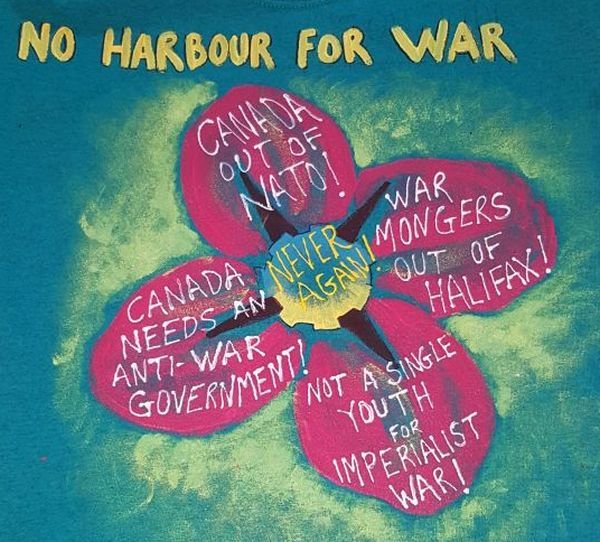
The focus of debate: what was our aim? The achievement of a nuclear condominium and modus vivendi of the arms race between the big powers? This was advertised as the yellow brick road to peace, the be all and end all of protest. Or to build independent political organization which could deal with the stark reality facing people in the eye in the harbour itself? Could people forget about the interference by conventional arms and troops in the sovereign affairs of the peoples of the world; accept the use of force to settle conflicts between peoples; and forget that the building of arms to destroy the homes and lives of other working people along with the destruction of the environment is an unacceptable and illegitimate way to create jobs and industry? They could not. “No harbour for war” based on unity in action emerged as the path forward.
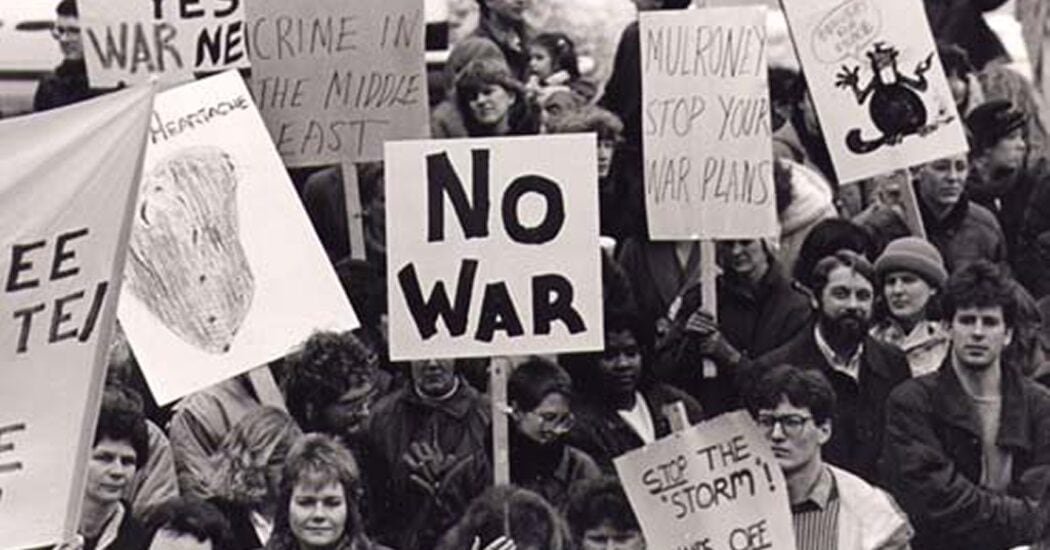
On the occasion of this solemn anniversary, the Trudeau Liberal government is pushing for further integration into the U.S. war machine precisely at a time when Trump and the U.S. ruling elite are organizing to launch further aggression against the world’s people. On January 30, 2020 the Federation of American Scientists revealed the U.S. has for the first time deployed a “low-yield” nuclear warhead (the W76-2) on a submarine that is currently patrolling the Atlantic Ocean, the USS Tennessee. The low-yield Trident nuclear warhead was commissioned in 2018 by Trump. [18]
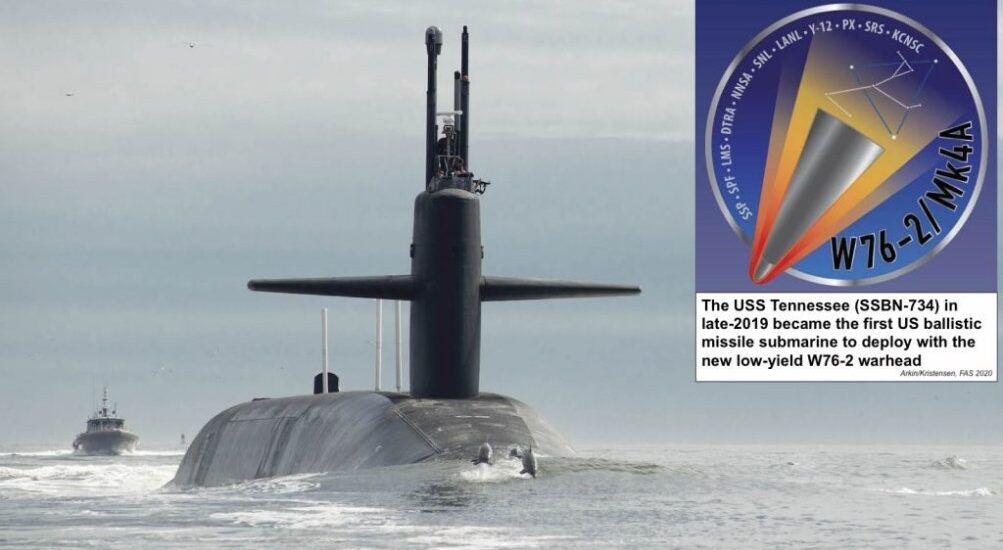
Repudiation of the crimes at Hiroshima and Nagasaki contributes to the profound sentiment of Canadians to Make Canada a Zone for Peace and of Haligonians to Make Halifax a No Harbour for War. Let us march on, unite in action with others and build the anti-war movement. Let us make the slogan Hiroshima and Nagasaki Never Again! a reality to build the organizations required to establish an anti-war government that makes Canada a Zone for Peace!
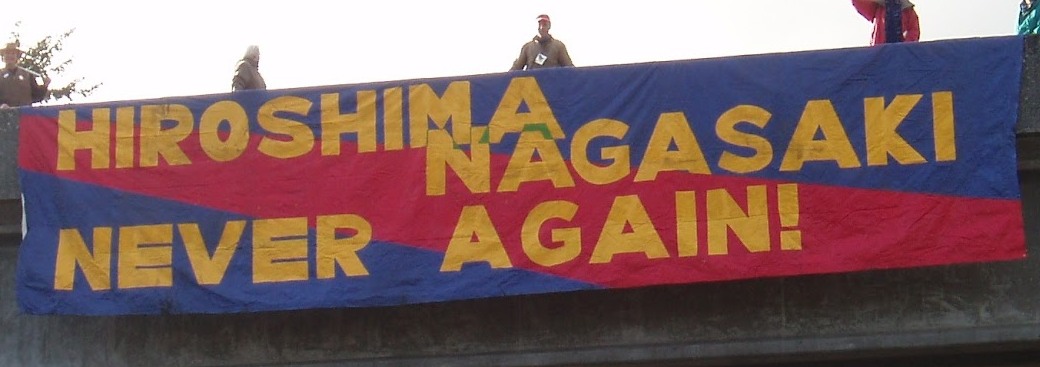
Halifax brought to the fore all over again – A timeline
The sea is a crucial terrain of the violent struggle for world domination by the international financial oligarchs and their client states. The USA annexes entire regions of the world through its control of sea-lanes and its pretext of “freedom of navigation.” The USA demands the integration of all naval forces and adherence to U.S. military doctrine through “inter-operability.” According to NATO covenants, the head of its naval forces must be an American admiral just as an American general commands the ground forces. The renewed battle for supremacy over the Atlantic sea lanes to Europe as well in the Caribbean has brought the historical role of Halifax and of the navy in the service of U.S. imperialism and its nuclear fleets to the fore all over again.
Halifax is the headquarters of Maritime Command with its large naval and air bases and dockyards, all situated amidst densely populated residential neighbourhoods, comprising one third of the population of Nova Scotia. It has the only natural, ice-free harbour on the Atlantic coast of North America. The well-being of thousands of longshoremen, railway workers, seamen, shipbuilding, refinery and service workers depend on this modern port. To the magnates of Halifax, the organization of the city as a war port is the ‘business’ best adapted for the extraction of maximum profits. Instead of developing the harbour so that it is only used for peaceful purposes – economic trade, shipbuilding and tourism – successive governments and big capital have used this strategic asset of the nation for empire-building, conquest and war, endangering all Canadians and the peoples of other lands. This further poses new threats of environmental degradation of the harbour, coast and marine ecosystem and accelerated economic and social decay of coastal communities.
As a reminder:
- The U.S. erected advanced radar bases (1961–) in Barrington and Sydney, NS during the Cold War to monitor the sea lanes;
- When the U.S. illegally blockaded Cuba in October 1962, Kennedy demanded that Canadian forces be put on high alert. Prime Minister John Diefenbaker insisted on consulting cabinet, but Canadian NORAD personnel were put on high alert before Cabinet authorization had been given. [11] At the direction of Washington, Maritime Command unilaterally deployed 22 destroyers and aircraft carriers with 28 planes, two subs, 12 shore-based anti-submarine planes and 22 patrol planes to participate in the naval blockade without cabinet approval [12];
- In the Caribbean, Canada sent warships as part of a U.S. fleet off the coast of Haiti during the 1963 uprising and the U.S. invasion of the Dominican Republic in 1965; began deploying warships to the Caribbean as part of the NATO Fleet formed in 1969; sent arms to Trinidad to crush a popular upsurge in 1970; sent troops to conduct intensive training in “jungle warfare” in Jamaica between 1969 and 1972 and helped destabilize the Manley government; sent RCMP forces following the overthrow of the Grenada government in 1983; participated in the illegal blockade and mining of the harbours of Nicaragua in 1984 and supplied ammunition to the Contra forces; and sent troops and RCMP forces to overthrow the Haitian government in 2004. It annually deploys warships and/or observers to participate in sabre-rattling U.S. Southcom exercises (e.g., UNITAS, Panamax, Tradewinds, Op Caribbe) along with NATO bloc members France, Netherlands and Britain, and NATO fleet exercises in the Caribbean, all of which are now aimed at Venezuela and its allies;
- Under Lester B. Pearson, Canada integrated the navy with the other branches of the military in the mid-1960s in order to standardize weapon platforms at the expense of European arms monopolies;
- The United States based nuclear weapons at CFB Greenwood (see charts below), never mind that it is not part of U.S. territory [13];
- In 1970, the U.S. Donner Foundation co-financed with DND the formation of the Centre for Foreign Policy Studies at Dalhousie to focus on seapower and “interoperability”, the first of several such specialized centres in maritime law of the sea, oceanography, offshore oil, etc.;
- On March 1, 1977 Canada declared a 200-nautical mile exclusive economic zone (EEZ) over three oceans: the Arctic, the Pacific, and the Atlantic. The area annexed by the federal government from the world ocean was vast: Canada’s oceans represent almost two thirds of its territorial land mass, and the area of the EEZ covers roughly half of its land mass of Canada, the second-largest country in the world. Significantly, however, the Canadian government, together with the US government, never implemented the Third United Nations Convention on Law of the Sea (UNCLOS-3) which – after years of bitter opposition from the United States and other great naval powers – made the 200-mile coastal limit part of international law. Implementation of UNCLOS-3 would have required an open public discussion on the difference between an “economic management zone” and a sovereign 200-mile territorial limit. Canada only ratified UNCLOS-3 in 1995, thirteen years after it was adopted in 1982; the USA has never ratified it. Instead of a sovereign 200-mile sea limit, it comprised a 12-mile territorial sea and a 188-mile “exclusive economic zone” rented out to the highest bidders, following which the ITQ system of “Individual Transferable Quotas” was brought to the fore to ruin inshore fishers and and corporatize and privatize the sea and its resources as well as neo-liberal arrangements regarding oil rigs, shipping lanes and marine pollution from oil spills. Nowhere in Canadian law is it defined as to what precisely a so-called “economic zone” is. This means it is whatever the executive decree or the federal cabinet decides, the precept known as Royal Prerogative, or ruling by Executive Decree, according to what favours the dominant interests of the day:
- In 1983, the Pentagon designated CFB Shearwater, originally established as a base by the U.S. Navy in August 1918, a forward deployment base for U.S. fighter squadrons stationed in New England in the event of war with the Soviet Union;
- In 1985, the Pentagon revealed secret plans for installing nuclear depth charges within Canadian waters and ports along with cruise missiles; it continuously used berthing facilities at CFB Shearwater in the community of Eastern Passage of the harbour of Halifax for its nuclear-armed submarine fleet;
- The Pentagon used the harbour of Halifax to prepare U.S. forces for intervention in other countries on many occasions. U.S. special forces which carried out the mining of the harbours of Nicaragua in 1984, condemned by the International Court of Justice as a violation of international law, carried out dress rehearsals in St Margarets Bay and the Bedford Basin (Operation Minex);
- Canada allowed U.S. Navy ships extra-territorial powers to operate shore patrols on Canadian soil, meaning that the sovereign powers of the Canadian state over “peace, order and good government” have been surrendered to a foreign armed force;
- Canada began modernizing the infrastructure of the port and the CFB Halifax and CFB Shearwater military-naval bases during the 1980s, permitting U.S. ownership of the container terminals, later followed by the Atlantic Gateway strategy sponsored by Irving to develop a modular transportation corridor to the U.S. heartland;
- In 1988, one month after Mulroney and Reagan signed the Free Trade Agreement on January 2, 1988, the government awarded a contract to the now cratered Irving shipyard in Saint John to construct six navy Halifax-class frigates designed and configured for anti-submarine warfare in the North Atlantic, which became obsolete in 1991 with the collapse of the USSR. according to US and NATO “standardized” specifications. The armaments of the Canadian warships included surface-to-surface (anti-ship) and surface-to-air missiles and anti-submarine torpedoes as well as Sea King helicopters which are used in reconnaissance and anti-submarine warfare. This fire-power of the 4,750-tonne Halifax-frigate class was not of a defensive nature. To illustrate, frigates designed for coastal defence average around 3,000-tonnes. Besides frigates, and securing the profits of the Irving monopoly, it secured the allegiance of the trade union, hitherto a supporter of the NDP, to its militaristic policies; it also had to promise that the frigate construction would not be disrupted by strike actions. Flush with revenues during this contract, Irving Shipbuilding went on a buying spree of several bankrupt or failing shipyards in eastern Canada, including the Halifax Shipyards in 1994;
- On August 25, 1990 a big political-media “ceremony” is staged at naval dockyards CFB Halifax to send off Canadian warships to the Middle East. The country’s first offensive military action since the Korean War is met with large-scale protests across Canada from Canadians, but all “major” political parties (Conservative, Liberal, NDP, Reform) endorse the war and the violation of the UN Charter and international law. During the U.S. Gulf War against Iraq, Canada deploys three ships (the HMCS Terra Nova, the HMCS Athabaskan and the supply ship HMCS Protecteur). Since the Gulf War, the Navy concentrated on increasing its rapid-deployment capabilities. Thus, whereas it took 21 days for navy ships to prepare to sail to the Persian Gulf in 1991, it took only 10 days for the navy to leave for the Arabian Sea in 2001. Warships are deployed later as part of the war against Yugoslavia in 1999, the invasion of Afghanistan in 2001 and Iraq in 2003. Maritime Command currently operates in North and West Africa in annual exercises as part of AFRICOM;
- In 1999 CBC News reported that tons of potentially toxic radioactive material were sitting just off the coast of Nova Scotia.The Canadian navy fired thousands of low-level radioactive shells into a target range near Halifax. Fishermen in the area said they had no idea depleted uranium was scattered over the fishing grounds.The navy replied that the ammunition was safe, but nuclear experts disagreed. Some say it could pose a serious hazard. Until about a year before the shells were fired from a Phalanx gun, which used shells made of depleted uranium, a byproduct of the nuclear industry. The hardened shells are used to penetrate armour plating. The guns were installed on Canadian ships just prior to the Gulf War. Over the years the navy fired six tons of depleted uranium shells, mostly into a fishing area near Eastern Passage, off Halifax harbour;
- In Summer 2001 Longtime Liberal cabinet minister Allan Rock and his family are flown by private plane to the Irvings’ exclusive lodge on the Restigouche River for a fly-fishing vacation they didn’t pay for. Defence Minister John McCallum was also on the trip, but was a back-bench MP at the time, and was not governed by cabinet conflict of interest rules. “Rock, who was health minister then and who became Industry Minister (which included the shipbuilding portfolio), even resorted to the standard Liberal reaction: I didn’t think I was doing anything wrong.” Conflict of interest guidelines were authored by Saint John MP Paul Zed, an Irving son-in-law;
- In 2002 Rock announced in a news release that he had named the vice-chairman of Irving Shipbuilding Inc. to the federal shipbuilding and industrial marine advisory committee;
- Canada adopted special laws to criminalize protest against naval bases in the pretext of “security” following the hysteria of 9/11 [14], and systematically placed Canadian forces and security agencies in the ports and the Coast Guard under U.S. command in various way. One such measure is the designation by the Canadian government by Order-in-Council on October 31, 2002 of the harbour of Halifax and the B.C. naval bases at Nanoose and Esquimalt “military security zones.” These zones give extraordinary powers to the Defence Minister over the port, and can be declared by just four cabinet ministers. The zones can be used to suppress public protest against “visiting forces” and to ensure the “security” of the U.S. and its “vessel(s), aircraft or other property.” All the laws of the country and provisions of the Charter of Rights and Freedoms are suspended in these zones;
- During January and February, 2002, the RCMP and a Senate committee headed by Senator Colin Kenney of Nova Scotia put it about everywhere that 15 to 39 per cent of stevedores in Canada’s ports have criminal records. Nevertheless, the RCMP inspector in charge of security at the Port of Vancouver, following a two-year investigation, informed the Senate’s national security committee in early 2005 that organized crime does not run the waterfront;
- On April 17, 2002 the U.S. declared a new regional command, NORTHCOM or Northern Command by then-U.S. Secretary of Defense Donald Rumsfeld. NORTHCOM was to, “as directed by the President or the Secretary of Defense, provide military assistance to civil authorities including consequence management operations,” Rumsfeld said. NORTHCOM was allocated responsibility for the continental United States, Canada, Mexico, portions of the Caribbean including Jamaica and Puerto Rico, and the contiguous waters in the Atlantic and Pacific oceans up to 500 miles off the North American coastline. (SOUTHCOM exercises control over Central and South America);
- On March 25, 2002 the U.S. deployed “unarmed” American customs agents in the Canadian ports of Halifax, Montreal and Vancouver, the three largest in Canada, where they joined CIA units already in place;
- On October 4, 2002 CBC reported that 16 shells had washed up on the Eastern Shore in the wake of Hurricane Juan and that the Canadian Forces had shut the highways down in the vicinity. In response to expressions of outraged concern from the Eastern Shore Fishermen’s Association at the time the DU exercises were revealed, Maritime Command declared they had no intention of “cleaning up” the DU, saying that it was safer to leave it where it was. Later they paid an “expert” from Dalhousie University who reportedly agreed that it was safe;
- During the run-up to the invasion of Iraq, the U.S. Consulate carried out espionage in Halifax; according to Wikileaks, it filed reports to the U.S. State Department with information from the commanding admiral of Maritime Command, Glen Davidson (later appointed ambassador to NATO, Afghanistan and Syria), on the level of the anti-war movement and the anti-American sentiment of sailors and officers within Maritime Command;
- In March 2003 longshoremen in Saint John declared war material to be shipped to Iraq “hot cargo” and again in December 2018 against armoured personnel carriers shipped to Saudi Arabia to be used against the Yemeni people. Port workers throughout the world have historically played an important role in frustrating wars of aggression;
- On June 27, 2003 Irving Shipbuilding announced that it had signed an agreement with the federal government (Industry Minister Allan Rock) for $55 million in economic readjustment funding provided that Saint John Shipbuilding be closed permanently. The Irving Group of Companies announced the intention of permanently decommissioning Canada’s largest shipyard and building a new wallboard manufacturing plant and other businesses on the site. In the preceding years, hundreds of skilled workers from Saint John had been recruited by U.S. shipbuilders;
- On December 1, 2003 the U.S. deployed President George W. Bush to Halifax to make his sole public speech in his visit to Canada, where he was condemned by 7,000 Nova Scotians; the invitation list was controlled by the U.S. Consulate, not the Martin government, the official host;
- In April 2004 the Martin government announced a new joint support warships contract involving more than $3 billion program for the transfer of public funds to private shipbuilding and armaments monopolies as part of the “modernization” and “transformation” of the Canadian Forces which then U.S. Defence Secretary Donald Rumsfeld and the Pentagon demanded from the NATO “allies. The three naval “joint support ships” to be commissioned are originally envisaged to be massive state-of-the-art command-and-control warships, unique in the world. They were being positioned to become a principal weapon for offensive operations in the seven seas of the world, wherever the U.S. Empire has need of them. This came at a time when The U.S. Navy – Status of the Navy revealed that 92 per cent of its surface ships were obsolete or deployed. The “joint support ships” combine a supply and provisioning role for forward combat operations and a command centre, capable of directing amphibious invasions of coastal and sovereign countries. According to Wikipedia, “The Joint Support Ship will enable a Naval Task Group to remain at sea for up to six times longer than is currently possible.” They were envisaged to be far superior in high-tech electronics and armour than anything afloat;
- The Harper government established a Rapid Reaction Force based at Shearwater and an Integrated Rapid Response Concept Development and Experimentation cell based in Halifax to study “the establishment of joint headquarters and the operation of expeditionary operations involving many diverse nations” of the NATO bloc (“CF Canadians participate in Black Sea multinational exercise,” Trident, July 23, 2007. p. 15);
- On November 16, 2006 under the aegis of the “war on terror” of the Bush administration, the federal government announced by executive order that maritime port workers in Canada will be required to pass background checks. The regulatory change, announced by Transport Minister Lawrence Cannon, meant that port workers who perform certain duties or who have access to certain restricted areas will need “transportation security clearance.” The requirements applied to seafarers, marine pilots, wharfingers, and security personnel.Workers at some Canadian ports have already been subjected to “routine screening” for criminal records. However, the new regime reportedly includes security-database checks, credit checks and immigration-database checks. The worker must “apply” and the “applicant” must provide a verifiable name, address, spouse’s name, names of family members, fingerprints, description of skin colour, work history and travel history. Relatives could be interviewed, and if any of this resulted in a “reasonable suspicion” about an applicant, he could be turned down. The “applicants” are reportedly to be vetted by the Canadian Security Intelligence Service, which will act as judge, jury and hiring hall.
The arbitrary measures implement the calls for a security perimeter for Fortress America made by the so-called Independent Task Force on the Future of North America and Liberal Party annexationist John Manley. The main thrust of the proposals from the Task Force were either already being implemented through the Smart Border Action Plan, NORAD reform, defence reform, Homeland Security exercises and the SMART (Specific, Measurable, Attainable, Realistic, and Timely) Regulation initiative. The Canadian Maritime Workers Council asserted that the measures are aimed to create “a false sense of security” and have very little to do, if anything, with “security”; - On June 7-8, 2007, under the banner of “expanding free trade”, the rich in Canada prepare destruction of workers’ rights and livelihood in the shipbuilding sector. A pact is signed with the member states of the “European Free Trade Area”, also known as EFTA.A key shipbuilding tariff of up to 25 per cent on foreign-built vessels coming into Canada, will be phased out;
- On June 11, 2007 unions and youth demonstrated against the Atlantica conference, Halifax, NS, sponsored by the Irvings, the Atlantic Institute of Market Studies (AIMS), New England capital and the Harper government. At the same conference, Peter MacKay, Minister for ACOA, handed over $548,000 to the Atlantic Provinces Chamber of Commerce to fund an Atlantica Council to develop the Atlantic Gateway Project;
- The Harper government, instead of developing Canadian shipbuilding and a merchant marine, centralized the multi-billion dollar assembly of a new fleet of bluewater warships, including command-and-control ships for amphibious landings in foreign countries, as well as for supremacy in the Arctic – comprising imported weapons, machinery and steel, hardly “job creation” – by the Irving empire. A blue-water navy is a maritime force with expeditionary capabilities. While definitions of what actually constitutes such a force vary, there is a requirement for the ability to exercise sea control at wide ranges. The U.S. Defense Security Service define a blue-water navy as “a maritime force capable of sustained operation across the deep waters of open oceans. A blue-water navy allows a country to project power far from the home country and usually includes one or more aircraft carriers. Smaller blue-water navies are able to dispatch fewer vessels abroad for shorter periods of time”;
- On September 3, 2009 Irving Shipbuilding – Halifax Shipyard is given a $194 million contract to build nine new mid shore the Hero-class patrol vessels. This contract for the Canadian Coast Guard will be the first large scale procurement of ships in 20 years. These 9 vessels are scheduled to be delivered by 2014-2015. Newly-installed NDP Premier Darrell Dexter and the province of Nova Scotia stepp up with 12.5 million dollars in performance loan guarantees;
- In 2009, the U.S. situated the Washington-organized, NATO-sponsored Halifax International Security Forum aka Halifax War Conference in Halifax, held annually and funded to date by DND and ACOA with corporate sponsorship from Lougheed Martin and Irving. Haligonians audaciously organized to protest each and every conference as well as renaming since 2009 Cornwallis Park, the site of their rallies and the notorious monument to the genocidaire Edward Cornwallis, a British military officer and so-called founder of Halifax, as Peace and Freedom Park, protests which are now spreading to other cities in Canada;
- In 2o10, the Davie shipyard in Lévis, Quebec goes in creditor protection and is ultimately taken over by an Italian monopoly;
- In October 2011, Irving Shipbuilding is deemed the successful proponent for constructing 23 warships for the Royal Canadian Navy, receiving the lion’s share of the $35 billion National Shipbuilding Procurement Strategy;
- In March 2012, the Nova Scotia government provides Irving with $304-million in funds – $260-million in a “forgivable loan” to help upgrade the yard for the ships, and $44-million loan to be repaid; in 2013 the Dexter NDP is removed as the provincial government – as Peter Kelly, the Tory mayor of Halifax, is replaced by ex-Liberal MP Mike Savage – and the Liberals reinstated, launching a vicious austerity program and all-round attack on organized labour;
- Since the 2014 coup d’état in Ukraine, private capital from Alberta has been scheming to develop a port in Goldboro specializing in the export of Liquefied Natural Gas from fracking natural gas to Germany and Central and Eastern Europe as part of the U.S. economic offensive against Russia;
- In April 2015 local authorities charged four visiting British Royal Navy sailors for the alleged gang rape at a military barracks at Shearwater of a civilian woman who courageously demanded justice; despite it being a criminal offence under Canadian law, they were allowed to return to England and ultimately exonerated of all charges;
- On September 20, 2015 Justin Trudeau accompanied by Nova Scotia Liberal Premier Stephen McNeil announced his military policy from a platform at Pier 21 in Halifax, that his government will expand the navy, including into the Arctic as well as to continue to swarm into all oceans of the world under the US and NATO command. “‘What the shipyard here in Halifax needs are guarantees that the money is going to flow,’ he said. The Liberal Party’s “Real Change” platform states “These investments will ensure that the Royal Canadian Navy is able to operate as a true blue-water maritime force, while also growing our economy and creating jobs”;
- Since 2016, Canada deployed warships from Halifax to the NATO Fleet operating in the Baltic, Black and Mediterranean seas as part of Operation Reassurance; Maritime Command has been exercising in the Black Sea since 1991;
- On July 1, 2017 on the 150th anniversary of the neo-colonial confederation, six racist hooligans from the navy, so-called “proud boys”, disrupted a Mi’kmaq ceremony demanding the removal of the Cornwallis statue and the declaration of Halifax as a zone of peace, given impunity by Maritime Command;
- On July 1, 2018 the U.S. reactivated the Second Atlantic Fleet headquartered in Norfolk, Virginia under which Maritime Command now operates. It was disbanded in 2011, as nothing challenged the U.S. Navy in the Atlantic Ocean at that time; and
- In July 2020, Halifax City Council voted to keep tthe Cornwallis statue in storage, rename Cornwallis Street, and renovate Cornwallis Park to become an arts-friendly Peace and Friendship Park.
Endnotes
[1] “102nd Anniversary of the Halifax Explosion,” Tony Seed, December 6, 2019
[2] Fire spread quickly to adjacent piles of ammunition, which had been stored outside because of overcrowding in the main compound. A chain reaction of fire, explosion and concussion rocked Halifax for a day. By late July 18, much of Halifax’s northern half had been evacuated. None of the explosions approached the force of the 1917 Halifax Explosion, but shattered windows, cracked plaster, occasional minor injuries and one death were reported. But for the heroic efforts of firefighters and naval personnel, there was no repeat of 1917. It could have been worse, as some 50,000 depth charges were reportedly saved from the fire. “As if their dangers were not enough, the parched woods all about the magazine on the Burnside slope caught fire and burned for two days,” Raddall informs.
Nevertheless, this explosion posed a real danger to families. One survivor of the explosion, Ruth Zatzman, whose husband was serving in the air force at Halifax, vividly remembers the day. They were living in Dartmouth. She told her son, “I was doing some ironing when I reached down to pick up some more clothes. At that very moment, I heard an explosion and the doorknob flew right above me, right where I had been standing.
“Until then throughout the war all the military families were being constantly reassured that the Halifax Explosion was a thing of the past, a once-in-a-lifetime ‘accident’.”
[3] “ATOMIC BOMBINGS AT 75: Truman’s ‘Human Sacrifice’ to Subdue Moscow,” Peter Kuznick, Consortiumnews, August 3, 2020.
[4] Ground Zero: A Reassessment of the 1917 Explosion in Halifax Harbour, Nimbus & Gorsebrook Institute; 1993
[5] “From Sahtú (Great Bear Lake) to Hiroshima and Nagasaki: Canada and the atom bomb,” Kim Petersen, April, 2005.
[6] The infamous statement was later expunged from The MacKenzie King Record, the 1968 biographical project of his literary executors, though his Diary was kept as a record to recount and explain the conduct of public affairs and is described in the official Canadian military history as “the most important single document in twentieth-century Canadian history.” The same liberal statesman also urged in 1944 that all “disloyal” Japanese-Canadians be deported as “soon as physically possible,” while those adjudged “loyal” should be physically dispersed.
[7] Lady Dunn, the wife of the financier Sir James Dunn of Algoma Steel, who made a fortune during World War II, was responsible for his appointment. Lady Dunn’s and Howe’s priority was science and “she offered substantial money”, the whole cost of a new building in fact. “The public announcement was made within forty-eight hours of Howe’s acceptance of the offer of chancellor. Thus Howe, Lady Dunn, and the Physics building – now to be called the Sir James Dunn Science Building – all came to Dalhousie at the same time.” The university also named the law building in his honour. Howe was executor of his estate and the two had neighbouring manors in St Andrews by the Sea in New Brunswick. He was chancellor until his death in 1960.
“In the Fast Lane: C.D. Howe, Lady Dunn, and Others, 1957-1963” in The Lives of Dalhousie University, Volume Two (1925-1980),
[8] Canada was a world leader in the development, testing and production of chemical weapons including mustard gas from 1939 to 1945. Trainloads of chemical munitions were dumped in the waters off Sable Island, Cape Breton Island, Bras d’Or Lakes and within the Gulf of St. Lawrence off the coast of Magdellan Islands.
See “Seismic tests, chemical munitions and the fishermen,” Myles Kehoe, Shunpiking Online, January 1, 2004; and “Mustard gas in the Bras d’Or Lakes,” Barry Barnard, Mi’kmaq-Maliseet Nations News, Shunpiking Online, October 2002
[9] U.S. bases in Canada are itemized by John Clearwater, Canadian Nuclear Weapons: The Untold Story of Canada’s Cold War Arsenal, Toronto: Dundurn Press, pp. 254-261.
[10] For in-depth information, see Dossier on Depleted Uranium, Shunpiking Online.
[11] For a historical overview, see “60th Anniversary of NORAD: The Demand to Dismantle NORAD Is More Urgent Than Ever,” TML Weekly, June 2, 2018 – No. 21.
[12] John Ward, “Admiral unilaterally sent Canadian warships as part of US maritime blockade of Cuba,” Vancouver Sun, on Shunpiking Online.
[13] Robert S. Norris, William Arkin, and William Burr, “Where They Were,” and “How Much Did Japan Know?,” The Bulletin of the Atomic Scientists, November-December 1999 and January-February 2000 respectively (may be available to subscribers only).
[14] An unequal agreement pushed through in December 2002 amidst the hysteria following 9/11 allows U.S. troops to enter Canada in response to a “threat, attack or civil emergency” concerning critical infrastructure or to protect “potential targets” such as critical infrastructure, nuclear power plants or oil and gas pipelines. Further, agreements under the NATO Status of Forces Agreement (SOFA) and the Visiting Warships Act grant immunity to American and foreign military personnel from prosecution in Canada.
[15] See “‘Liberty visits’ (I): Return of the ‘Dial-a-sailor’ program?” and “‘Liberty visits’ (II): Who will pay the bill?, Tony Seed, June 22, 2007.
[16] “‘Mock disaster’ aboard visiting US nuclear sub, and the disinformation of the Chronically Horrid,” Tony Seed, Shunpiking Online, October 15, 2006; Chris Lambie, “Planning for disaster: ‘Terrorist’ attack focus of exercise,” Halifax Chronicle-Herald, October 12, 2006.
[17] “On board the Eisenhower,” El Jones, Halifax Examiner, July 7, 2017
[18] “US Deploys New Low-Yield Nuclear Submarine Warhead,” Federation of American Scientists Security Blog, William M. Arkin and Hans M. Kristensen, January 29, 2020.
See also: Halifax Day of Peace: “Hiroshima was a city so similar to Halifax that it is frightening”
Reproduced, with permission, from Tony Seed’s excellent blog.
With a special thanks to our generous donors who make publication of the Nova Scotia Advocate possible.
Subscribe to the Nova Scotia Advocate weekly digest and never miss an article again. It’s free!


